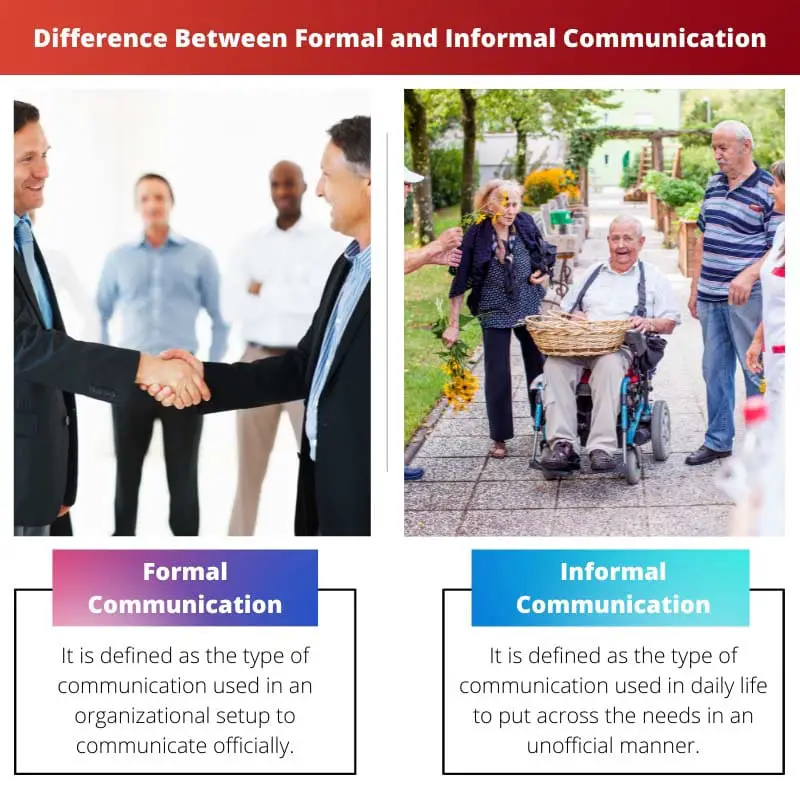The two types of communication help a person fare well in expressing one’s thoughts and viewpoints.
It is easier to put a point across when the person has acquired the necessary skills to balance the words and tone.
Most importantly, it is essential to aptly clothe the thoughts into appropriate words in order to make oneself understood in front of a group of people or an authoritarian figure.
Key Takeaways
- Formal communication is used in professional or official settings, while informal communication is used in casual or personal settings.
- Formal communication is more structured and follows established rules, while informal communication is more relaxed and spontaneous.
- Formal communication is more polite and respectful, while informal communication is more familiar and friendly.
Formal Communication vs Informal Communication
The difference between formal communication and informal communication is that the former requires a deliberate attempt to sound sophisticated while the latter requires nothing more than a free flow of words used in the common lexicon. Both of them can be differentiated on the basis of words used, expressions observed, pitch of voice, way of communicating, and visible body language.

Formal communication is also known as official communication, as all official dealings require a particular standard of vocabulary and tonal quality.
It is not that this type of communication requires any special linguistic skills, but one has to use proper forms of general words in order to sound serious and considerate.
Anyone can easily indulge in formal communication with colleagues, mentors, employers, or company associates.
Informal communication is also known as unofficial communication due to its usage in day-to-day life for having conversations with family members or friends.
There is no protocol that needs to be followed, and the person is free to use personal jargon or short forms of words.
The use of a single language is also not a compulsion, as such friendly talks can be done in any way the person finds comfortable.
Comparison Table
| Parameters of Comparison | Formal Communication | Informal Communication |
|---|---|---|
| Definition | It is defined as the type of communication used in an organizational setup to communicate officially. | It is defined as the type of communication used in daily life to put across the needs in an unofficial manner. |
| Importance of Body Language | Body language is essential as it conveys the interests of the person talking. | Body language does not hold much value as informal communication only requires expression in any way. |
| Tone Used | A respectful and polite tone is important. | A friendly and light-hearted tone is important. |
| Types Included | Horizontal and diagonal communication. | Gossip and grapevine communication. |
| Application | To convey the duties and take feedback. | To share life’s happenings and express one’s feelings. |
What is Formal Communication?
Formal communication occurs when two people are discussing issues that are important to the furthering of an organization.
This type of communication is essential for maintaining decorum in the workplace or while greeting senior members of the same discipline.
Other areas of application include talking to a professor, seeking help related to directions, and negotiating terms for a job proposal.
The essentials of formal communication are based on the standards set by the respective organization. One must use a proper salutation and regard the other person in a respectful manner.
Body language is important because one is supposed to maintain a specific posture in front of authoritative figures and conduct the body in a more organized manner.
Every action and word matters in formal communication.
Making use of respectful words and some essential phrases enhance the way a person talks in such a setup.
Other facets of formal communication include waiting for an appropriate chance, talking at a moderate pace, controlling aggression, and listening to the other person as well.

What is Informal Communication?
Informal communication occurs every time two people talk in a casual fashion, without thinking about how the thoughts are being put across.
The vocabulary does not hold much importance as far as informal communication is concerned. Regional language can also be used. This type of communication also helps in maintaining social relationships in day-to-day life.
The essentials of informal communication are scarce – a speaker and a listener. There are no more rules attached to this mode of communication.
The use of slang is also acceptable, and the parties engaged in informal communication need not be concerned about the tone, pitch, delivery, or any related category. It is important to speak clearly so that the listener can understand and subsequently comprehend the words.
The vocabulary should be immaterial for this type of communication. There should be a flow of thoughts, and anyone can indulge in meaningful informal communication.
It is essential that the parties understand a common language for ease of understanding.

Main Differences Between Formal And Informal Communication
- Formal communication is defined as the mode of communication that uses the complex vocabulary for exchanging ideas in an organizational setup. On the other hand, informal communication is the easy process of simple talks that take place between affiliated members without any focus on vocabulary or mode of expression.
- Body language is of utmost importance in formal communication as it shows signs of interest or disinterest, while informal communication is almost independent of any expression in the form of body language.
- The tone should be light and obedient while indulging in formal communication. In contrast, informal communication can be conducted using a casual or friendly tone as well, without paying much heed to the choice of words or the way in which they are arranged in the form of a meaningful sentence.
- Various types of formal communication include horizontal and diagonal communication. On the other hand, informal communication can be inclusively categorized into gossip and grapevine communication.
- Formal communication finds application in offices, colleges, and other organizations where there is an authoritarian hierarchy. As far as infromal communication is concerned, it has no limitations and can be used to communicate with family members, friends, and other acquaintances.

